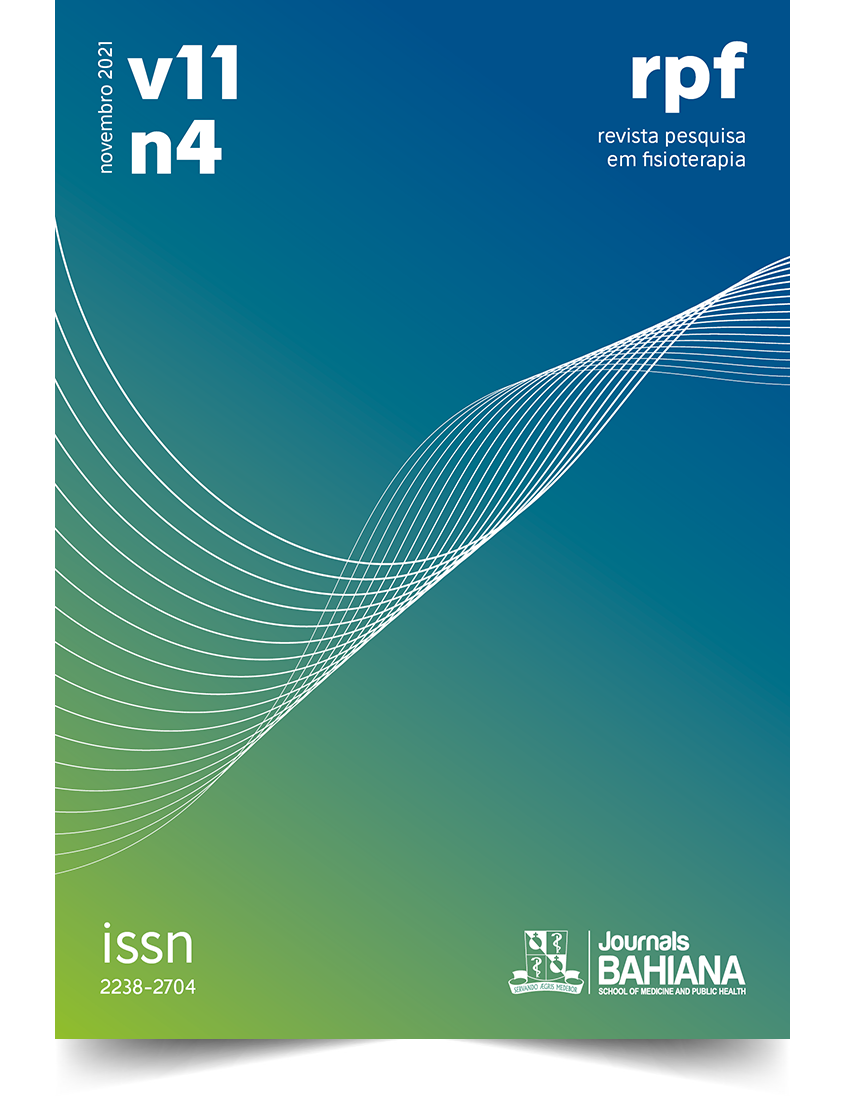Equilíbrio e força de membros inferiores correlacionam-se com velocidade de marcha em pacientes com AVC: um estudo observacional
DOI:
https://doi.org/10.17267/2238-2704rpf.v11i4.4162Palavras-chave:
Acidente vascular cerebral, Força muscular, Marcha, Equilíbrio, Velocidade de marchaResumo
INTRODUÇÃO: A marcha e o equilíbrio são frequentemente comprometidos após lesões cerebrais como o Acidente Vascular Cerebral (AVC). OBJETIVO: Correlacionar a força dos membros inferiores e o equilíbrio em apoio unipodal no membro parético com a velocidade de marcha em pacientes com AVC. MÉTODOS: Estudo do tipo observacional transversal. Indivíduos de ambos os sexos com diagnóstico de AVC atendidos no Ambulatório de Neurovascular do Hospital de Clínicas de Porto Alegre, que conseguissem permanecer emortostase por dois minutos sem auxílio e com marcha domiciliar com ou sem auxílio de dispositivos de marcha, foram avaliados quanto a força muscular de MsIs, por meio do Teste de Sentar e Levantar em 30 segundos (TSL30s); avaliação do equilíbrio pelo Teste de Apoio Unipodal (AU) e da velocidade da marcha pelo Teste de Caminhada de 10 metros (TC10m) com auxílio de um acelerômetro fixado na região de L5. RESULTADOS: Dos trinta e quatro indivíduos avaliados, 67,6% eram do sexo feminino, com média de idade de 60,5 (± 13,6) anos. A velocidade de marcha confortável média foi 1,01 ± 0,31 m/s, a média no TSL30s foi 9 ± 2,94 repetições e o tempo médio de apoio no membro inferior acometido foi de 4,11 ± 10,43 segundos. Houve correlação dos valores no TC10m com o tempo de permanência no lado acometido (r=0,563 p<0,001) e com o número de repetições no TSL30s (r=0,667 p<0,001). CONCLUSÃO: Quanto maior a força muscular dos MsIs e o equilíbrio em apoio unipodal sobre o membro inferior acometido, maior a velocidade de marcha nos pacientes com AVC.Downloads
Referências
Luvizutto GJ, Gameiro MO. Effect of the spasticity on standards of gait in hemiparetic. Fisioter Movi. 2011;24(4):705-12. https://doi.org/10.1590/S0103-51502011000400015
Tally Z, Boetefuer L, Kauk C, Perez G, Schrand L, Hoder J. The efficacy of treadmill training on balance dysfunction in individuals with chronic stroke: a systematic review, Top Stroke Rehabili. 2017;24(7):539-46. https://doi.org/10.1080/10749357.2017.1345445
Moriello C, Finch L, Mayo NE. Relationship between muscle strength and functional walking capacity among people with stroke. J Rehabil Res Dev. 2011;48(3):267-76. http://dx.doi.org/10.1682/jrrd.2010.04.0066
Seo JP, Lee MY, Kwon HY, Jang SH. Delayed gait recovery in a stroke patient. Neural Regen Res. 2013;5(8):1514-8. http://dx.doi.org/10.3969/j.issn.1673-5374.2013.16.008
Balaban B, Tok F. Gait Disturbances in Patients With Stroke. Pm&r. 2014;6(7):635-42. http://dx.doi.org/10.1016/j.pmrj.2013.12.017
Beaman CB, Peterson CL, Neptune RR, Kautz SA. Differences in selfselected and fastest-comfortable walking in post-stroke hemiparetic persons. Gait Posture. 2010;31(3):311-16. http://dx.doi.org/10.1016/j.gaitpost.2009.11.011
Antunes JE, Justo FHO, Justo AFO, Ramos GC, Prudente COM. Influência do controle postural e equilíbrio na marcha de pacientes com sequela de acidente vascular cerebral. Rev Fisioter S Fun [Internet]. 2016;5(1):30-41. http://www.repositorio.ufc.br/handle/riufc/19343
Dorsch S, Ada L, Canning CG. Lower Limb Strength Is Significantly Impaired in All Muscle Groups in Ambulatory People with Chronic Stroke: a cross-sectional study. Arch Phys Med Rehabil. 2016;97(4):522-7. http://dx.doi.org/10.1016/j.apmr.2015.10.106
Warren M, Ganley KJ, Pohl PS. The association between social participation and lower extremity muscle strength, balance, and gait speed in US adults. Prev Med. 2016;4:142-47. http://dx.doi.org/10.1016/j.pmedr.2016.06.005
Jones CJ, Rikli RE, Beam WC. A 30-s chair-stand test as a measure of lower body strength in community-residing older adults. Res Q Exerc Sport. 1999;70(2):113-9. http://dx.doi.org/10.1080/02701367.1999.10608028
Rikli RE, Jones CL. Development and validation of a functional fitness test for a community-residing adults. J Aging Phys Act. 1999;7(2):129-61. https://doi.org/10.1123/japa.7.2.129
Bohannon RW, Larkin PA, Cook AC, Gear J, Singer J. Decrease in timed balance test scores with aging. Phys Ther. 1984;64(7):1067-70. http://dx.doi.org/10.1093/ptj/64.7.1067
Cho BL, Scarpace D, Alexander NB. Tests of stepping as indicators of mobility, balance, and fall risk in balance impaired older adults. J Am Geriatr Soc. 2004;52(7):1168-73. http://dx.doi: 10.1111/j.1532-5415.2004.52317.x
Peters DM, Fritz SL, Krotish DE. Assessing the reliability and validity of a shorter walk test compared with the 10-meter walk test for measurements of gait speed in healthy, older adults. J Geriatr Phys Ther. 2013;36(1):24-30. http://dx.doi.org/10.1519/jpt.0b013e318248e20d
Helgason CM, Wolf PA. American Heart Association Prevention Conference IV: prevention and rehabilitation of stroke. Circulation. 1997;96(2):701-7. http://dx.doi.org/10.1161/01.cir.96.2.701
Beinoitti F, Correia N, Christofoletti G, Borges G. Use of hippotherapy in gait training for hemiparetic post-stroke. Arq Neuro-psiquiatr. 2010;68(6):908-13. http://dx.doi.org/10.1590/s0004-282x2010000600015
Khanittanuphong P, Tipchatyotin S. Correlation of the gait speed with the quality of life and the quality of life classified according to speed-based community ambulation in Thai stroke survivors. Neurorehabil Neural Repair. 2017;41(1):135-41. http://dx.doi.org/10.3233/nre-171465
Oberg T, Karszinia A, Oberg K. Basic gait parameters: Reference data for normal subjects, 10-79 years of age. J Rehabil Res Dev. 1993;30(2):210-23. Cited: PMID: 8035350.
Lewek MD, Bradley CE, Wutzke CJ, Zinder SM. The relationship between spatiotemporal gait asymmetry and balance in individuals with chronic stroke. J Biomech. 2014;30(1):31-36. http://dx.doi.org/10.1123/jab.2012-0208
Taylor-Piliae RE, Daniel L, Hepworth JT, Coull BM. Predictors of gait velocity among community-dwelling stroke survivors. Gait Posture. 2012;35(3):395-99. http://dx.doi.org/10.1016/j.gaitpost.2011.10.358
Mentiplay BF, Adair B, Bower KJ, Williams G, Tole G, Clark RA. Associations between lower limb strength and gait velocity following stroke: a systematic review. Brain Inj. 2014;29(4):409-22. http://dx.doi.org/10.3109/02699052.2014.995231
Lecours J, Nadeau S, Gravel D, Teixera-Salmela L. Interactions between foot placement, trunk frontal position, weightbearing and knee moment asymmetry at seat-off during rising from a chair in healthy controls and persons with hemiparesis. J Rehabil Med. 2008;40(3):200-7. http://dx.doi.org/10.2340/16501977-0155
Boukadida A, Piotte F, Dehail P, Nadeau S. Determinants of sit-to-stand tasks in individuals with hemiparesis post stroke: a review. Ann. Phys. Rehabil. 2015;58(3):167-72. http://dx.doi.org/10.1016/j.rehab.2015.04.007
Carvalho C, Sunnerhagen KS, Willén C. Walking Performance and Muscle Strength in the Later Stage Poststroke: a nonlinear relationship. Arch Phys Med Rehabil. 2013;94(5):845-50. http://dx.doi.org/10.1016/j.apmr.2012.11.034
Carr JH, Edinburgh RS. Neurological rehabilitation: optimizing motor performance. Physiother Can. 2010;67(2):215-16. https://doi.org/10.3138/ptc.67.2.rev2
Eng JJ, Tang P. Gait training strategies to optimize walking ability in people with stroke: a synthesis of the evidence. Expert Rev Neurother. 2007;7(10):1417-36. http://dx.doi.org/10.1586/14737175.7.10.1417
Downloads
Publicado
Edição
Seção
Licença
Copyright (c) 2021 Caroline Camerin, Rafael Dias Bittencourt, Luciano Palmeiro Rodrigues

Este trabalho está licenciado sob uma licença Creative Commons Attribution 4.0 International License.
Esta obra está licenciada com uma Licença Creative Commons Atribuição 4.0 Internacional.



